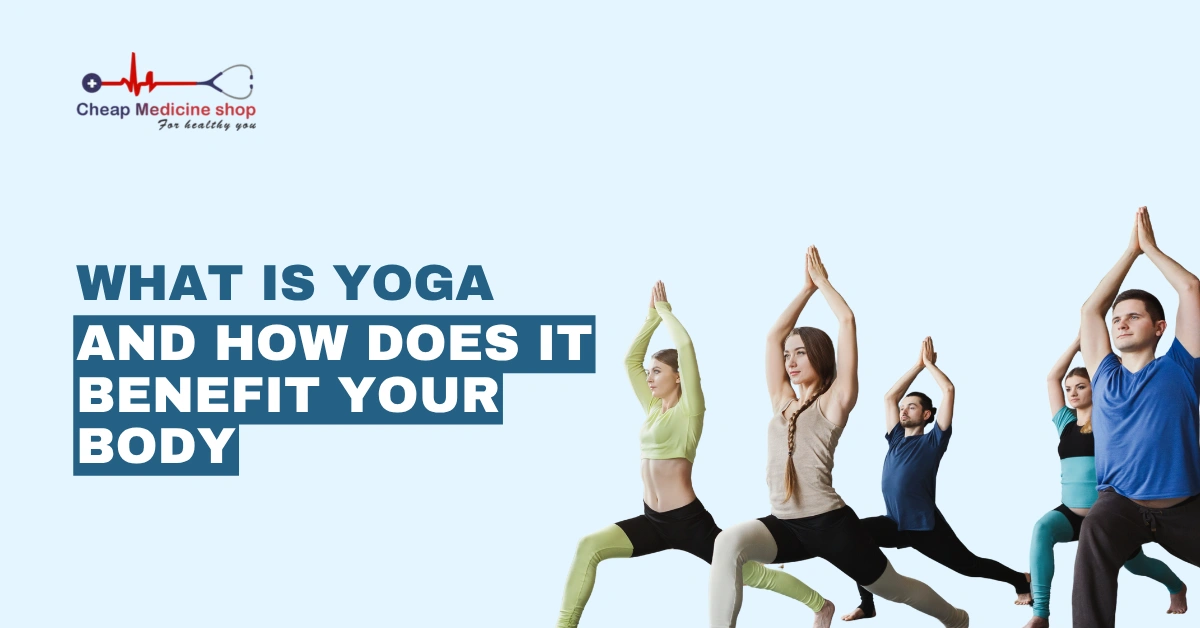Yoga is a holistic practice that combines breath, body movement, and meditation to promote healing of the mind and body. Its roots originate from India, stretching thousands of years into history.
Today, millions of people turn to this wellness practice for stress relief, flexibility, and overall fitness. According to the International Journal of Yoga, 14.3% of adults in the US use this spiritual exercise as a type of complementary medicine.
Over the years, yoga transformed from a spiritual practice into a popular wellness practice. Modern methods focus on relaxation techniques, physical poses, and breathing exercises. Whether you are seeking peace, good health, or energy, this mind-body practice provides balance.
This article will make yoga easier for you to understand and guide you through its traditional and modern types. We will further discuss its benefits, safety tips, and how to begin your yoga journey for a healthy life.
What is yoga?
Yoga is an ancient practice developed to harmonize the body, mind, and spirit. The term yoga comes from Sanskrit, meaning union or joining. Originally, it was a spiritual approach for some Asian civilizations, emphasizing personal growth, meditation, and values.
Today, yoga is used in modern classes where asanas (physical poses) are combined with meditation and breathing exercises. These practices offer numerous health benefits, including mental clarity, increased strength, and improved flexibility.
These further teach focus, discipline, and self-awareness, which are essential life skills. When practiced regularly, yogic practices can lead to inner peace and increased resilience in managing stress.
Save up to 90% on your medicine bills

Carmel Organics Ashwagandha Extract Tablets

Neuherbs Ashwagandha 1000 Plus Tablets

Myherb Ashwagandha Powder

Your Happy Gummies
Types of yoga
This holistic practice has many types, each developed to support different personalities, goals, and needs. Some forms promote strength and movement, while others enable spiritual growth and relaxation. Let us read the types in detail:
Traditional types
These types are focused on spiritual awakening and achieving inner peace:
- Hatha yoga: It includes foundational and slow-paced poses. Such poses are suitable for beginners. This type focuses on breath and postures to promote mindfulness and relaxation. Poses include stretching of the shoulders, spine, and hips.
- Kundalini yoga: A spiritual practice that combines meditation, chanting, movements, and breathwork. It helps awaken spiritual energy (Kundalini) located at the base of the spine. Kundalini form involves repetitive poses that target the chest and spine.
- Ashtanga yoga: Traditional Ashtanga is well-structured and physically intense. Its literal translation is eight-limbed and involves a specific sequence of eight principles that focuses on controlled breathing, flexibility, and strength. This form utilizes continuous movement, engaging the deep core muscles, legs, and arms.
- Bhakti yoga: A combination of chanting and rituals, this focuses on love and devotion to focus on union with the Divine. This kind helps in gaining inner peace. It promotes compassion and emotional well-being in the practitioner.
- Karma yoga: This is also known as the practice of selfless action, which involves performing duties for the greater good with no attachment to the outcomes. This type helps develop discipline and a sense of purpose.
- Raja yoga: Known as the royal path, it focuses on mind control and meditation for spiritual liberation. This style involves eight limbs of yoga to enable self-awareness and inner peace.
- Jnana yoga: It’s called the path of knowledge and wisdom, involving meditation and self-inquiry to gain a deeper understanding of oneself. It helps strengthen mental clarity.
- Tantra yoga: A mystical practice that includes energy-focused techniques and meditation to boost consciousness. It is usually a combination of breathwork and posture to achieve spiritual awakening.
Modern types
The types listed below are widely practised in gyms and yoga studios:
- Vinyasa yoga: This is also known as flow yoga, which aligns movement with breath in a flowing sequence of poses. This style builds balance, coordination, and endurance. Movements include upward and downward body stretching.
- Bikram yoga: A kind of hot yoga that involves 26 poses performed in a fixed sequence within a heated room. High temperature (41°C) enables flexibility as well as sweating to eliminate toxins. The sequence generally includes floor and standing poses to strengthen legs and back.
- Iyengar yoga: A detailed form that uses props like straps or chairs for focused alignment. It helps develop stability, awareness, and flexibility. The stretching focuses on smaller muscles, joints, and the spine.
- Yin yoga: Yin form is slow-paced, meditative, and calm. It targets joints and deep tissues. Poses include stretching of the pelvis, lower spine, and hips for longer periods to increase patience and flexibility.
- Restorative yoga: A relaxed and gentle strategy to enable deep relaxation and lower stress. The poses are held for 5-10 minutes and include floor-based positions. Props like blankets or bolsters are used for smooth movements.
- Prenatal yoga: It supports pregnant women by relieving pregnancy-related symptoms and stress. Poses include gentle movements of the pelvic region, hips, and lower back for stability. This type prepares the body for childbirth.
- Power yoga: A fitness-oriented, intense style that builds strength, flexibility, and stamina. Its poses are often inspired by Ashtanga and involve engagement of legs, arms, and core.
- Acro yoga: Acro style is a combination of acrobatics and yoga that is performed with a partner. It enhances coordination, balance, and trust. Poses are performed on the ground, and movements include flips and lifts.
- Aerial yoga: It involves gravity-assisted movements and can be practised with a partner or solo. It includes the use of a suspended hammock or silk and promotes core strength and reduces pressure on the spine.
Benefits of yoga
Yoga benefits both body and mind through a blend of movement and mindfulness. It provides numerous benefits that support both mental health and physical fitness. It can transform daily routines by enhancing focus and energy. Key benefits include:
Physical benefits
It offers more than just flexibility. Physically, it benefits as follows:
- Heart health: Certain styles, such as Pranayam (breathing exercise) or Tadasana (mountain pose), can increase blood circulation and lower blood pressure. This helps in enhancing cardiovascular health.
- Muscle tone and strength: Numerous poses, such as Virabhadrasan II (warrior II) and Utkatasana (chair pose), support overall muscle tone and increase muscle strength.
- Reproductive health: This ancient discipline is known to improve blood flow, which can help with Erectile Dysfunction (ED) in men. Moreover, it can relieve Polycystic Ovary Syndrome (PCOS) symptoms by enhancing hormonal balance.
- Better posture: Body slumping and spinal misalignment are managed by supporting the shoulders, spine, and pelvis. This holistic practice helps develop a stronger core, increasing body awareness and further improving posture.
- Balance and flexibility: Holding poses and stretching enable improving the range of motion. Postures, such as Vrikshasana (tree pose), stretch muscles in the hips, knees, feet, and ankles to improve flexibility and body steadiness.
- Bone and joint health: It supports joint and bone health through weight-bearing poses, such as the mountain pose. This holistic exercise also protects bone density by lowering cortisol (a stress hormone) levels, which, when elevated, can trigger bone breakdown. This further prevents bone demineralization and the risk of Osteoporosis.
Mental benefits
As previously discussed, this fitness discipline supports mental health by promoting calmness and enhancing cognitive function. Given below are the core benefits:
- Better sleep: Relaxation through the mind-body practice promotes better sleep quality. A study conducted by the Industrial Psychiatry Journal in 2021 found that sleep quality improves by 38.68% after 45 minutes of yoga intervention.
- Stress control: Meditation and breathing techniques help control stress and manage anxiety issues.
- Emotional balance: Breathwork, physical postures, and meditation help balance emotions by activating the Parasympathetic Nervous System (PNS). PNS is responsible for body relaxation.
- Self-confidence: Asana practice leads to body positivity, increased self-awareness, and enhanced inner strength. Together, these factors enhance self-confidence.
- Mental clarity: Regular practice boosts Gamma-Aminobutyric Acid (GABA) levels. The GABA molecule plays a key role in calming brain activity. So, its increased levels promote mental calmness, enhancing thought processing, focus, and attention span.
How to get started with yoga
Starting with this breath and body practice is easy, and it is not dependent on your fitness level. Here are some steps to begin the holistic journey:
- Find suitable classes: Look for local gyms, studios, or online courses that offer beginner-friendly services.
- Inform the instructor: Select a beginner class and inform the instructor of your health history for personalized guidance.
- Comfortable clothing: Wear clothing that allows for easy stretching and movement.
- Listen to your body: Body signals, such as feeling the need to rest or modify poses, should not be ignored for safe practice.
- Begin with basics: Start with gentle stretching, breathing tricks, and basic poses. Progress gradually over time.
Risks linked with yoga
It is generally considered safe for most people. However, understanding potential risks helps ensure a safe and rewarding practice. Risks include:
- Overexertion: Going beyond capability or comfort level can lead to injuries, particularly during hot or intense yoga.
- Not for everyone: Although typically safe, this holistic exercise is not meant for everyone. Individuals with chronic health issues or injuries should consult a doctor first.
- Physical injuries: There is a possibility of strains, muscle aches, and sprains if poses are misaligned or forced.
- Pre-existing conditions: Those with recent surgery, heart ailments, or Glaucoma will need a doctor’s consultation before beginning this ancient practice.
Points to consider while doing yoga
Safe yogic practices begin with following basic precautions and listening to your body. Keeping in mind the points mentioned below will help achieve the best outcomes and prevent injury:
- Hydration: Be sure to hydrate well, especially during hot yoga sessions.
- Use props: For added comfort and support, props can be used, particularly during the Iyengar or restorative method.
- Cooling time: Proper cool-down time is essential after doing sessions. Wait for at least 30 minutes before eating or taking a bath after a session.
- Avoid: Avoid doing yoga after a heavy meal, as it can cause nausea. Try practicing on an empty stomach.
- Stop when in pain: In case of persistent pain or body aches, stop and consult a doctor.
Conclusion
Yoga is more than the usual exercise. It is an ancient practice that maintains spiritual, physical, and mental well-being. It combines meditation, breath, and movement. With regular practice, it builds inner calm and provides strength.
From gentle yin yoga to powerful hatha yoga, there is a type to suit every individual’s requirements. Traditional forms can help achieve spiritual awakening and peace. In contrast, modern methods enable the development of flexibility and strength by using props (such as aerial forms) and heat (in hot yoga).
Additionally, it offers physical benefits, such as improved reproductive health, and mental benefits, including stress reduction. At the same time, learning about risks enables safe practice.
Getting started with this healing discipline is simple. You can find local studios and begin with gentle stretches. Furthermore, it is crucial to take precautions and listen to your body. This meditational practice is not about achieving perfection, but rather about balance and progress toward a calmer, healthier life.
Frequently Asked Questions
What are the five pillars of yoga?
The five pillars of yoga include Pranayama (proper breathing), Asana (proper exercise), Savasana (proper relaxation), proper diet, and Vedanata and Dhyana (positive thinking and meditation). These five pillars, when combined, enable a healthy lifestyle by integrating mind, breath, spirit, and body.
Does yoga improve libido?
Yes, yoga is known to improve libido by strengthening mental as well as physical aspects of sexual health. It helps lower stress and anxiety, which are the general triggers of low libido. It also enhances blood flow and increases body awareness, all of which further promote better sexual function.
What is the magic number in yoga?
The number 108 is considered a sacred or magic number in spirituality and yoga. 108 represents unity and spiritual completion. Many yogic practices feature performing 108 sun salutations and chanting mantras 108 times.
What is the final stage of yoga?
The final stage of yoga is called samadhi, which represents liberation or enlightenment. Samadhi is considered the 8th and final limb of ashtanga yoga. This stage represents complete withdrawal from the outside world by attaining a stage of total bliss.
Cheap Medicine Shop only refers to credible, authoritative sources for our content. If you’re curious about how we ensure the integrity of our content, we encourage you to read our Content Information Policy.














